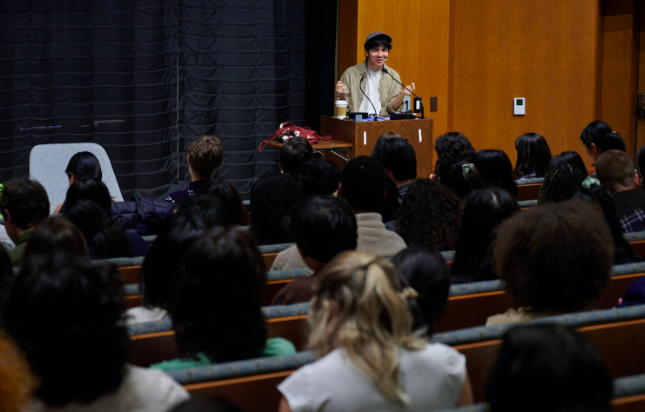“A space of co-creation”: Yale Review Festival connects student, professional writers
The annual Yale Review Festival, which took place from April 8 to 11, featured generative writing workshops with speakers such as Catherine Lacey, Ocean Vuong and Raven Leilani.

Courtesy of David Surowiecki
From April 8 to April 11, the rooms of the Humanities Quadrangle came to life for the annual Yale Review Festival.
This year’s festival featured panels, roundtables, writing workshops and readings. Students could hear from and converse with professional poets, novelists, critics, playwrights, musicians and historians, as well as editors of the Yale Review. Featured speakers included Ocean Vuong, Lucy Sante, Jonathan Lethem, Raven Leilani and Catherine Lacey, among others.
“The goal of the festival is to bring The Yale Review to students, to bring the pages alive into the rooms of the festival and to bring in a space of co-creation between writers and students,” said Meghan O’Rourke, editor of the Yale Review, in her introduction of the festival.
This year’s festival was the “most ambitious yet,” said O’Rourke.
The festival also hosted generative workshops — sessions in which audience members participated in writing exercises that experimented with the body, memory and language.
These sessions invited Catherine Lacey, author of “The Biography of X”; Ocean Vuong, author of “On Earth We’re Briefly Gorgeous”; and Raven Leilani, author of “Luster.”
Lacey’s fiction generative workshop invited audience members to incorporate sensations of the body into the way they respond to and produce writing.
Reflecting on her own experiences with figuring out her writing voice, Lacey described the process of writing her first published novel, “Nobody is Ever Missing.” For Lacey, she initially thought of writing as a “purely intellectual thing.” Later, she became aware of a “physical sensation” that accompanied her voice when she wrote.
“There’s an internal kind of system, like a physical manifestation of the voice of the syntax that feels very bodily,” Lacey said.
Recreating this feeling for her audience members, Lacey asked them to stand up and close their eyes. Lacey read excerpts from Thomas Bernhard’s “Woodcutters,” Ia Genberg’s “The Details” and Henry Hoke’s “Open Throat.”
Lacey told participants to be aware of the “tensions and differences” that these writings evoked within the body. Following each reading, Lacey asked the audience to share the specific sensory experience that they felt. Then, students were asked to write a scene that evoked one of these sensations.
“The body is very much present with you at your desk and your posture, your breathing and the tension in your body is affecting everything that you’re creating. You’re hearing the sentences in your mind as if they’re being kind of breathed into life,” Lacey said.
In his generative workshop, Vuong also shared his insights into his writing process. Vuong emphasized the significance of challenging the prevailing need to focus on the end result.
Living in “a country that fetishizes commerce,” Vuong said that this culture of consumerism has “contaminated” the way art is perceived.
Seeking to shift the focus of writing from product to process, Vuong encouraged writers “to sit in the space of thinking and questioning and being okay with its imperfections.”
“You’re not going to get anything close to a poem, just a few lines,” said Vuong.
Vuong told the audience to write down their biographical information — their given name, date of birth, place of birth and every specific place they have lived. Vuong then asked the audience to identify and draw a map of their place of residence, as well as its interior and neighborhood surroundings.
Fleshing out their memories further, participants were asked to jot down the sounds, lingo, significant objects and feelings that were evoked by or found in their chosen living spaces. Participants finished this exercise by writing one to two lines of poetry that emerged from this memory map.
Raven Leilani’s prose workshop also challenged participants to reimagine the ways they used language in their writing.
Leilani told participants to write a brief autobiography or a biography of a fictional character. Then, participants wrote from the same prompt two additional times without using any of the same language as the original paragraph.
Through this exercise, writers could build upon what they had previously written in order to explore the nuances and tensions within a sentence and use varying language to articulate their ideas.
By comparing the first and last entries they wrote, audience members could “see the distance between them” and go beyond “the familiar ways we have told the story,” said Leilani.
The Yale Review is the oldest quarterly literary magazine in the United States.







